in NORTH AMERICA, FALL 2016
the energy needed for its preservation will never be developed" ~ Thomas Berry
Email: bron@religion.ufl.edu
Office: Anderson 121
Office hours: Thursday 1:00-3:00 and by appointment
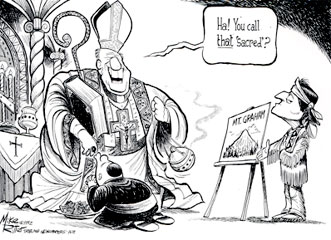 This course critically examines the roles played by “religion” and “nature” during the evolution of the cultural, political, and environmental history of North America. Specifically, it considers questions such as:
This course critically examines the roles played by “religion” and “nature” during the evolution of the cultural, political, and environmental history of North America. Specifically, it considers questions such as:- What are the various and contested ways terms such as “religion” and “nature” are understood, and do such understandings enhance or constrain our ability to apprehend their reciprocal influence in American cultural, political, and environmental history?
- Have the habitats of North America shaped human consciousness, including “religious” or “spiritual” perceptions, ritualizing, and ethical practices, and if so, how? This question will be in mind throughout the course, from an examination of the cultures of the continent’s “first peoples,” to religionists, environmentalists and scientists in the 20th century.
- How and to what extent have religions of various sorts influenced human behavior in ways that contributed to the transformation of North American ecosystems?
- What roles have religiously-shaped concepts of nature played in American political history? For example, how have notions such as “natural theology” “natural law” and understandings of “sacred nature” influenced social life and natural systems during the history of the United States?
- How have religion-related nature discourses, attitudes, and practices been shaped by, and shaped European cultures, and later, by such developments in international spheres?

Albert Bierstadt, "Yosemite Valley", 1866
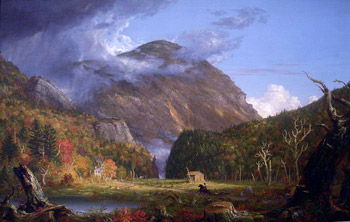
Thomas Cole, 1839
"A View of the Mountain Pass Called
the Notch of the White Mountains"
- Religion & Nature with Early European Contacts (1000-1600)
- The arrival, first of the Norse, then the Spanish and other European peoples, set in motion dramatic and sometimes devastating changes to the land, its first inhabitants, and the new immigrants. Religion had much to do with the character of these encounters and these changes.
- The Colonial Period (1600-1775)
- Fear, Ambivalence, and the Stirrings of Reverence toward Nature in the Colonial Period to the Founding of the Republic (ca. 1600-1776).
- Religion & the Ideology of Manifest Destiny as the violent collision of European and Native American Religious Cultures escalate.
- Early Republic to the End of the Frontier (ca. 1780 to 1890)
- The subjugation of wild peoples and places (continued).
- The European tributary of aesthetic, religious, and romantic attachments toward nature,
- Transcendentalism and romantic theologies of correspondence.
- Wildness and wilderness emerge as nature religion.
- The End of the Frontier to Earth Day (1880-1970)
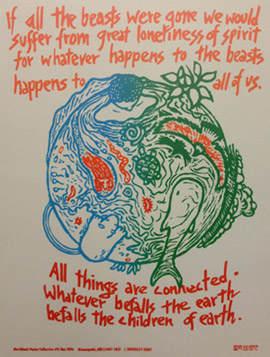
- Forest Reserves & National Parks; Scouting and Indian Guides.
- Nature writing, Back to the Land Movements, and early "post-supernaturalistic spiritualities of connection."
- the Land Ethic (1948), Sea Mysticism & Silent Spring (1962).
- "The Historic Roots of our Ecologic Crisis" (1967) and the turn toward the indigenous cultures of Turtle Island (1969) and those originating in Asia.
- Religion and Nature from Earth Day & the Age of Environmentalism (1970 to present)
- Asian, Pagan, and Native American Spiritualities as Nature Religions.
- the "Greening" of some factions of the World's Major Religions.
- The growth of Scientific Nature Religion, including Systems Ecology and the Odumites; Conservation Biology and Restoration Ecology; "Intelligent Design" and its variants; and the Consecration of Scientific Narratives in Cosmos, The Epic of Evolution, & the Universe Story
- Environmentalism and Religion
- Reactionary Responses
- International Dimensions and Future Trends
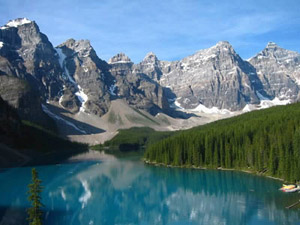 Note: most of the required books can be found inexpensively from online and other used booksellers. Wherever available, required book readings will also be available on reserve at the library. Additional articles will be available online via links found in the course schedule.
Note: most of the required books can be found inexpensively from online and other used booksellers. Wherever available, required book readings will also be available on reserve at the library. Additional articles will be available online via links found in the course schedule.- Albanese, Catherine L. Nature Religion in America: From the Algonkian Indians to the New Age. Chicago: Chicago University Press, 1990.
- Deloria, Vine (Jr.). God Is Red: A Native View of Religion. Updated ed. Golden, Colorado: 1972; reprint, Golden, Colorado: Fulcrum, 1994.
- Nash, Roderick Frazier. Wilderness and the American Mind. 4th ed. 1967; reprint, New Haven: Yale University Press, 1967.
- Pike, Sarah. New Age and Neopagan Religions in America. New York: Columbia University Press, 2004.
- Stoll, Mark. Inherit the Holy Mountain: Religion and the Rise of American Environmentalism. Oxford University Press, 2015. Note, this book replaces John Gatta's Making Nature Sacred: Literature, Religion, and Environment in America from the Puritans to the Present. Oxford University Press, 2004.
- Gould, Rebecca Kneale. At Home in Nature: Modern Homesteading and Spiritual Practice in America. Berkeley, CA: University of California Press, 2005.
- Sears, John. Sacred Places: American Tourist Attractions in the Nineteenth Century. New York & Oxford: Oxford University Press, 1989.
- Emerson, Ralph Waldo. Nature. Boston, MA: Beacon Press, 1986 (reprint); also in Emerson, Ralph Waldo. The Essential Writings of Ralph Waldo Emerson. Edited by Brooks Atkinson. New York: The Modern Library, 2000. Or Essays and Lectures (includes Nature) Library of America, 1983.
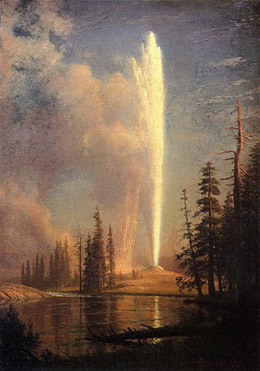
Albert Bierstadt, "Old Faithful", 1886 - Muir, John. Nature Writings. Edited by William Cronon. New York: Library of America, 1997. This is the best single volume of Muir's writings and it belongs in religion and nature scholars libraries.
- Thoreau, Henry David. There are many editions; two from the Library of America are nicely produced, 1985 & 2004
- Burroughs, John. Accepting the Universe. New York: Houghton Mifflin Company, 1920. Commemorative Edition, George W. Lugg, ed., reprint of 1920 publication; Moore Haven, Florida: Rainbow Books, 1987, or 2001 edition from Fredonia Books; and Time and Change (the Complete Writings of John Burroughs). Amsterdam: Fredonia Books, 2001
- Carson, Rachel. Silent Spring. New York City: Houghton Mifflin, 1962; The Sea Around Us. New York: Oxford University Press, 1950; Under the Sea Wind. New York: Dutton, 1991; The Edge of the Sea. Boston: Houghton Mifflin, 1955. Carson, Rachel. Lost Woods: The Discovered Writing of Rachael Carson. Edited by Linda Lear. Boston: Beacon Press, 1998.
- Emerson, Ralph Waldo. Nature. Boston, MA: Beacon Press, 1986 (reprint); also in Emerson, Ralph Waldo. The Essential Writings of Ralph Waldo Emerson. Edited by Brooks Atkinson. New York: The Modern Library, 2000.
- Eiseley, Loren. The Immense Journey: An Imaginative Naturalist Explores the Mysteries of Man and Nature. New York: Vintage, 1959; The Firmament of Time. New York: Atheneum, 1960; The Invisible Pyramid. New York: Scribners, 1970; The Unexpected Universe. New York: Harcourt, 1972; The Star Thrower (anthology). New York: Harcourt/Harvest, 1979; All the Strange Hours. Lincoln: University of Nebraska Press, 2000.
- Jefferson, Thomas, Notes on the State of Virginia, Penguin Classics, 1998.
- Leopold, Aldo. The Sand County Almanac with Essays from Round River. Oxford: 1949; reprint, New York: Sierra Club and Balentine Books, 1971.
- Muir, John. Nature Writings: The Story of by Boyhood and Youth; My First Summer in the Sierra; The Mountains of California; Stickeen; Essays. Edited by William Cronon. New York: Library of America, 1997.
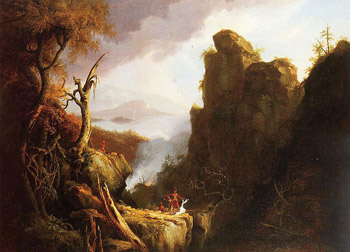
Thomas Cole, "Indian Sacrifice", 1826
- This is a reading-intensive class so a high priority will be placed on the quality of preparation, participation, and thus also attendance (30%). To ensure careful preparation, there will be regular, unannounced, quizzes held in class based on the readings, or, students will be asked to submit by email, normally no later than midnight Tuesday (otherwise by announcement), a 300-500 word summary of the major arguments being articulated in the major reading, and identify major fault lines and competing perspectives. The weeks in which these short essays will be required will be announced in class, by email, or placed in the reading schedule; so pay attention!
- Multiple choice in class & take home essay mid term exam (30%); see class schedule for details.
- Multiple choice and short answer final exam (40%); see class schedule for details.
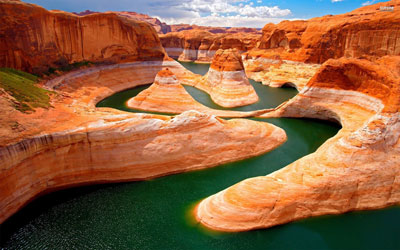 Consistent attendance, quality of preparation, & participation (15%). Normally, by no later than Wednesday evening (otherwise by announcement), students are to email a 500-800 word summary of the major arguments being articulated in the major readings, with some reflection on the relationship among these arguments and other currents in the class, first in other readings from that week, and then, with regard to other theoretical streams they are encountering. In other words, after articulating the arguments being advanced and what is at stake with regard to them, you are to identify the fault lines and competing perspectives that are emerging and make connections among the various understandings. If the key readings are not argumentative, then you should describe the perspective(s) presented and note connections among this week’s and prior readings. Remember that the course has to do with religion and nature in America, so you should be especially alert to and engaged in analysis of the religious dimensions of the arguments, figures, movements, and so on, that appear in your readings. In fall of 2013 you will also be regularly called upon to explain and interpret readings that the undergraduates have not had in their assignments.
Consistent attendance, quality of preparation, & participation (15%). Normally, by no later than Wednesday evening (otherwise by announcement), students are to email a 500-800 word summary of the major arguments being articulated in the major readings, with some reflection on the relationship among these arguments and other currents in the class, first in other readings from that week, and then, with regard to other theoretical streams they are encountering. In other words, after articulating the arguments being advanced and what is at stake with regard to them, you are to identify the fault lines and competing perspectives that are emerging and make connections among the various understandings. If the key readings are not argumentative, then you should describe the perspective(s) presented and note connections among this week’s and prior readings. Remember that the course has to do with religion and nature in America, so you should be especially alert to and engaged in analysis of the religious dimensions of the arguments, figures, movements, and so on, that appear in your readings. In fall of 2013 you will also be regularly called upon to explain and interpret readings that the undergraduates have not had in their assignments.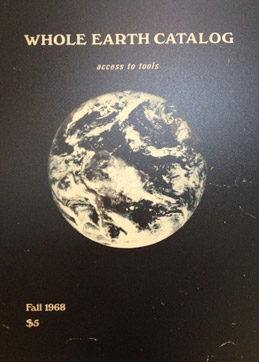 Biographical, Movement Research, or Controversy Analysis (& related classroom presentation). (15%) Each student will either (1) read the major writings of and about seminal figures or (2) read about movements critical to the America’s religion and nature ferment, and then, provide written, and if time allows, oral reports to the classroom, as negotiated with and scheduled through agreement with the instructor. In your presentations you should endeavor to situate the subject within the broader cultural ferment of the time. Presentations focused on individuals will include the reading of biographies (see course bibliography for some examples). A third option will be to read into a critical controversy, such as related to Frederick Jackson Turner’s “Frontier Thesis” and its “New Western History” detractors, analyzing the controversy’s relevance to this course’s critical questions. Whatever else they do, all presentations will bring the same sorts of critical questioning to these analyses as identified under #1, above.
Biographical, Movement Research, or Controversy Analysis (& related classroom presentation). (15%) Each student will either (1) read the major writings of and about seminal figures or (2) read about movements critical to the America’s religion and nature ferment, and then, provide written, and if time allows, oral reports to the classroom, as negotiated with and scheduled through agreement with the instructor. In your presentations you should endeavor to situate the subject within the broader cultural ferment of the time. Presentations focused on individuals will include the reading of biographies (see course bibliography for some examples). A third option will be to read into a critical controversy, such as related to Frederick Jackson Turner’s “Frontier Thesis” and its “New Western History” detractors, analyzing the controversy’s relevance to this course’s critical questions. Whatever else they do, all presentations will bring the same sorts of critical questioning to these analyses as identified under #1, above.- Mid term exam with in-class and take-home essay components (30%)
- Final exam: with in-class and essay dimensions specified in the course schedule (40%).
 This course is an important one for Religion and Nature graduate students seeking competence in Occidental traditions in general and North America in particular. It is also an elective in the Religions in the Americas concentration. Given that other courses are offered that focus on Asian and Abrahamic religions, and do so making a priority of examining developments since 1970, the priority in this course is historical. The central objective is to illuminate broad cultural trends and nature-related practices and transformations, rather than attempting to survey the world's major religious traditions, and their natural dimensions, in America.
This course is an important one for Religion and Nature graduate students seeking competence in Occidental traditions in general and North America in particular. It is also an elective in the Religions in the Americas concentration. Given that other courses are offered that focus on Asian and Abrahamic religions, and do so making a priority of examining developments since 1970, the priority in this course is historical. The central objective is to illuminate broad cultural trends and nature-related practices and transformations, rather than attempting to survey the world's major religious traditions, and their natural dimensions, in America.| Assignment | Points per Assignment | Total Possible Points |
|---|---|---|
| Quizzes & Summaries | 10 or 20 points each | 150 (30%) |
| Midterm Exam | 150 points | 150 (30%) |
| Final Exam | 200 points | 200 (40%) |
| Total Possible Points: | 500 (100%) |
| Assignment | Points per Assignment | Total Possible Points |
|---|---|---|
| Weekly Summaries | 10-20 points each | 75 (15%) |
| Research Presentation | 75 points | 75 (15%) |
| Midterm Exam | 150 points | 150 (30%) |
| Final Exam | 200 points | 200 (40%) |
| Total Possible Points: | 500 (100%) |
| 93% | A |
| 90% | A- |
| 87% | B+ |
| 83% | B |
| 80% | B- |
| 77% | C+ |
| 67% | C |
| 60% | D |
| 59% | F |
Course instructor reserves the right to lower or raise course grades based on classroom contributions or upon absences. Instructor also reserves the right to change course requirements.
Starting with a question: Does surfing (ocean not internet) have anything to do with religion, nature, and ethics in North America? If so, why?
Native American and European cultures and nature from contact to the end of the colonial period.- From the Encyclopedia of Religion and Nature (henceforth the ERN): S. Kretch American Indians as 'First Ecologists'; F. Berkes, Traditional Ecological Knowledge
- Albanese, Nature Religion in America, "Introduction" & "Native Ground: Nature & Culture in Early America," pp. 1-46 (Intro & ch. 1)
- Bron Taylor, "Surfing into Spirituality" (pdf or html ) from the Journal for the American Academy of Religion 75/4, 2007.
- Bron Taylor, "Aquatic Nature Religion" (pdf or html)
- Stoll, Inherit the Holy Mountain, Introduction and Ch. 1
- Recommended: Gatta, Making Nature Sacred, Introduction and "Landfall," pp. 3-33; "Meditating on creatures in early American life and letters," pp. 34-54; re. "Intimations of an environmental ethic in the writings of Jonathan Edwards," 55-70 (chs. 1-3)
- From the ERN: Anishnabeg Culture; Harmony in Native North America; Lakota; Sacred Geography in Native North America; Shoshone (Western North America); Shamanism-Traditional; Traditional Ecological Knowledge among Aboriginal Peoples in Canada; Yoeme (Yaqui) Ritual
Readings (below) will explore the entwinment of nature and religion attending the birth of the republic.
The documentary The Faithkeeper (Bill Moyers interview of Oren Lyons) will be made available; view during the first two weeks of the semester.- From the ERN: Haudenosaunee Confederacy; Deism; Book of Nature; Christianity (7h)-Natural Theology
- Albanese, Nature Religion ..., "Republican Nature" pp. 47-79 (ch. 2)
- Nash, Wilderness and the American Mind, xii-43 (chapters 1 & 2)
- Nash, Wilderness ..., "The Romantic Wilderness" and "An American Wilderness," pp. 44- 83 (ch. 3 & ch. 4)
- Stoll, Inherit the Holy Mountain, Ch. 2 & 3
- Recommended: Gatta, Making Nature Sacred, "Revelation to US: Green shoots of romantic religion in Antebellum America," pp. 71-99 (ch. 4)
- From the ERN: Unitarianism; Manifest Destiny
- Thomas Jefferson, Notes on the State of Virginia,Aborigines pp. 98-113; The Administration of Justice pp. 137-155, and Religion pp. 163-167.
New streams of aesthetic and spiritual appreciation of nature emerge and evolve in the early republic's first century and to the end of the frontier.
Documentary: Segments from The National Parks: America's Greatest Idea (2009)- Nash, Wilderness ..., "Henry David Thoreau;" pps. 84-95, (ch. 5)
- From the ERN: Transcendentailsm; Emerson, Ralph Waldo
- From the ERN: Thoreau, Henry David
- Albanese, Nature Religion ..., re. "Wilderness and the Passing Show" (on Transcendental
Religion), pp. 80-116 (ch. 3) - Gatta, Making Nature Sacred, "Variations on Nature: from the Old Manse to the White Whale," pp. 102-125 (ch. 5), which is about early 19th century poets and writers; and "Rare and delectable places: Thoreau‘s imagination of sacred space at Walden," pp. 127-142 (ch. 6)
- John Sears, Sacred Places, re. nature appreciation and pilgrimage, first 1⁄2 19th century, pp. 1-71
- Stoll, Inherit the Holy Mountain, Ch. 4
- Ralph Waldo Emerson, Nature and other selections.
- Henry David Thoreau, Selections from Bron Taylor‘s Thoreau Appendix in Dark Green Religion, which Dr. Taylor will provide via email)
- Nash, Wilderness ..., "Preserve the Wilderness" and "Wilderness Preserved," pp. 96-121 (chs. 6 & 7 (read quickly)
- From the ERN (European tributaries): Romanticism-in European History; Romanticism in European Literature; Rousseau, Jean-Jacques; (American manifestations): Romanticism-American; (See also a contemporary reading by a LDS scholar of the natural aspects of the teaching of Joseph Smith and others in the entry): Church of Jesus Christ, Latter Day Saints.
- Cedar Grove, the National Park Service sponsored site devoted to Thomas Cole, and the Hudson River School of Art, which he founded.
- The Catskill Archive, a site devoted to the history of the Catskill Mountains, has many images from Thomas Cole's paintings.
* Note the differences between the various periods of his work, and the environmental and religious values in the paintings, as well as the view of environmental history implicit in them, especially in the "empire" series.
John Muir and the ambivalent ethical legacy of American National Parks
Documentary: Segments from The National Parks: America's Greatest Idea (2009).- Reading summaries due by the end of Tuesday, 20 September.
- From the ERN: National Parks and Monuments; Pinchot, Gifford; Muir, John; Sierra Club
- John Muir. From Nature Writings. Edited by William Cronon. New York: Library of America, 1997. Read, Cedar Keys, pp. 818-827; Wild Wool, pp. 598-606
- Nash, Wilderness and the American Mind, "John Muir," pp. 122-140, "The Wilderness Cult," pp. 141-160, and "Hetch Hetchy," pp. 161-181 (chs. 8-10)
- Stoll, Inherit the Holy Mountain, Ch. 5 - 7
- Mark David Spence. Introduction & Looking Backward and Westward, pp. 1-23, The Heart of the Sierras, Yosemite Indians and the National Parks Ideal, and Conclusion, pp. 101-139. (Dispossessing the Wilderness: Indian Removal and the Making of the National Parks. Oxford University Press, 1999.)
- John Sears, Sacred Places, re. The Sacred & National Parks nature appreciation and pilgrimage, second 1⁄2 19th century pp. 122-216 (chs 6-8)
- John Muir. Nature Writings. Edited by William Cronon. New York: Library of America, 1997. In addition to the required readings, strongly recommended are Stickeen, pp.553-571; and then skim widely, looking especially for his emerging biocentrism and ambivalent attitudes toward Native Americans, in "My First Summer in the Sierra*," pp. 147-309. [Note: this is the volume you should all get for your libraries]
- Lynn Ross-Bryant. Pilgrimage to the National Parks: Religion and Nature in the United States, London: Routledge 2012
- Kerry Mitchell, “Managing Spirituality: Public Religion in National Parks,” Journal for the Study of Religion, Nature and Culture 1/4 (2007): 431-49. For a more in-depth work see his Spirituality and the State: Managing Nature and Experience in America's National Parks, NYU Press 2016.
- ERN: Miwok People
- Dispossessing the Wilderness (the remaining chapters) pp. 24-100,* and Robert Keller and Michael Turek, Everglades National Park and the Seminole Problem, pp. 216-231, from American Indians and National Parks. Tucson: Arizona University Press, 1998.
Theorizing "Dark Green Religion"
Documentary: Segments from The National Parks: America's Greatest Idea (2009)- Reading summaries due by the end of Tuesday, 27 September.
- Taylor, Bron, Dark Green Religion, Preface & Ch. 1, Exploring Critical Terms (Ch. 1 begins at the bottom of the preface); Ch. 2, Dark Green Religion, and Wilderness, Spirituality and Biodiversity in North America: tracing an environmental history from Occidental roots to Earth Day, in Wilderness in Mythology and Religion, ed. Laura Feldt, (Berlin: De Gruyter, 2012), 293-324; Recommended: Ch. 3, Dark Green Religion in North America in Dark Green Religion.
- Stoll, Inherit the Holy Mountain, Ch. 8 & Conclusion.
-
- The Dark Green Religion website has a variety of supplementary materials that students may enjoy perusing, including video, music, and images.
Insights and corrections to the most prevalent narratives about religion and nature in North America from the emerging discipline of environmental history.
Documentary: American Values / American Wilderness (High Plains Films/2005)No weekly analysis is due on 4 October but students should be ready to address the readings during the in-class and take home portions of their mid-term exam.
6 October: The in-class portion of the mid-term exam will be administered 6 October in class and the take home essay section will be distributed. The take-home essay will be due 13 October before class and submitted as a word or rich text document by email. Students not in class that day will receive a 1 grade deduction on the essay portion of the mid term.
- ERN: Scouting
- Kimberly Smith, "What Is Africa to Me? Wilderness in Black Thought, 1860-1930," Environmental Ethics 27/3, 279-97.
- Paul Sutter, The World with Us: The State of American Environmental History, Journal of American History, 2013.
- Bron Taylor, Its not all about us, Journal of American History, 2013.
- Rebecca Gould, At Home in Nature, especially "Ambivalent Legacies II: Gender, Class, Nature, and Religion" 201-235.
- ERN (recommended): Indian Guides; Nature Fakers Controversy; Ernest Thompson Seton Institute & Seton biography (Brief)
- Eileen Smith-Cavros, 'Modern Black Churchgoers in Miami-Dade County, Florida: Place, Nature, and Memory, Journal for the Study of Religion, Nature and Culture 1/3: 351-70, 2007.
- New books indirectly pertinent: Ian Finseth, (2009). Shades of green: visions of nature in the literature of American slavery, 1770-1860. University of Georgia Press, 2009; Diane Glave and Mark Stoll, eds. To love the wind and the rain: African Americans and environmental history. Pittsburgh, University of Pittsburgh Press, 2006.
John Burroughs & Loren Eiseley: science & nature religion in the early & mid-20th century
Religion and resistance to Darwinian thought and scientific nature religion
Documentary: Thinking Like a Watershed (1998) (or next week)- ERN: Back to the Land Movement; Creationism and Creation Science
- John Burroughs. Preface and The Long Road pp. 1-38, and The Gospel of Nature pp. 243-73, in Time & Change (vol. xv) in The Complete Writings of John Burroughs) Amsterdam: Fredonia Books, 2001. Commemorative Edition, George W. Lugg, ed., reprint of 1920 publication; Moore Haven, Florida: Rainbow Books, 1987, or 2001.
- ERN: Eiseley, Loren
- Loren Eiseley, The Flow of the River pp. 15-27, The Judgment of the Birds pp. 163-78, The Bird and the Machine pp. 179-93, and The Secret of Life pp. 195-210, from The Immense Journey, and The Star Thrower pp. 67-92, from The Unexpected Universe (or reprinted in The Star Thrower). The Small Death pp. 139-49, and The Coming of the Giant Wasps" (pp. 236-47), and The Other Player (258-66) from All the Strange Hours.
- Rebecca Gould, At Home in Nature, pp. 1-138 (ch. 1-4).
- ERN: Darwin, Charles
Students not in class on 13 October will receive a one grade deduction on the essay portion of the mid term that is due prior to that class.
Aldo Leopold, the Wilderness Society, and the breakthrough of explicitly biocentric environmental ethics.
Recommended: Wild By Law (The American Experience/PBS, 1992): on Marshall, Leopold & Zanheiser and the Wilderness Society.
Documentary: Green Fire / Aldo Leopold (2011)* Special note: Fall 2016, these documentaries (and the one on Rachel Carson listed next weeks) will be shown on 20 October during a special documentary festival.
- Reading summaries due by the end of Tuesday, 18 October. Since these will cover two weeks, undergraduates may take up to 1,000 and graduates up 1,500 words
- ERN: Environmental Ethics
- Nash, Wilderness ..., "Aldo Leopold: Prophet," pp. 182-99, "Decisions for Permanence," pp. 200-237, (chs. 11-12)
- Aldo Leopold, from A Sand County Almanac: Foreword, Arizona and New Mexico (especially sub-section, Thinking like a Mountain) and The Land Ethic. (Note: The Oxford University Press edition (1949/1968) does not have Part III, which includes the Round River and Goose Music essays. For these, see the Ballentine Books (1970) paperback edition.
- Strongly Recommended: read widely, esp. "A Sand County Almanac" and "Wilderness" and "Conservation Esthetic."
Rachel Carson, the environmental Era, the environmental justice movement, and the rising influence of nature writing.
Documentary: Rachel Carson's Silent Spring (The American Experience, 1993)
- Reading summaries due by the end of Tuesday, 25 October.
- ERN: Carson, Rachel; Environmental Justice & Environmental Racism; Williams, Terry Tempest
- Rachel Carson, Nature Religion Selections. See also selections and commentary on Silent Spring. Recommended, peruse Under the Sea Wind, about which she ruminated in the hyperlinked selections, or read Preface and The Marginal World (pp. 1-7), and The Enduring Sea (pp. 249-50), in The Edge of the Sea (1955), or read widely from The Sea Around Us or Silent Spring (in this, her most famous book, see especially the introductory Fable for Tomorrow (pp. 1-3), and the concluding section, The Other Road pp. 177-97, esp. its concluding two pages).
- Kathleen Dean Moore, The Truth of the Barnacles: Rachel Carson and the Moral Significance of Wonder.In Rachel Carson: Legacy and Challenge.
- ERN: Dillard, Annie; Berry, Wendell; Lopez, Barry
- Sarah McFarland Taylor, Land as Lover: Mormon eco-eroticism and planetary plural marriage in the work of Terry Tempest Williams Nova Religio vol. 8 no 1 (July 2004): 39-56
- Terry Tempest Williams,Epilogue: The clan of the one-breasted women, pp. (pp. 281-90), in Refuge: an Unnatural History of Family and Place. New York: Pantheon, 1991. Also, see Desert Quartet: an erotic landscape. New York: Pantheon, 1995.
- Recommended: Gatta, Making Nature Sacred, "Post-Darwinian Visions of Divine Creation," pp. 143-173, "Imagined Worlds: the lure of numinous exoticism," 175-198, "Reclaiming the sacred commons," 199-224, "Learning to love creation: the religious tenor of contemporary ecopoetry," 225-243, (chs. 7-10), and "Afterword," 245-46.
- Lisa Sideris and Kathleen Dean Moore, eds. Rachel Carson: Legacy and Challenge. State University of New York Press, 2008.
Developments from & since the 1960s.
Documentary: American Buffalo: Spirit of a Nation (PBS/Nature, 1998)- No reading summaries due this week.
- ERN: Deloria, Vine Jr.
- Vine Deloria (Jr.) God is Red (peruse/skim the entire book, reading carefully 1-113 (ch 1- 6), pp. 185-202 (ch 11); pp. 236-282 (ch. 14-16).
- ERN: Bison Restoration and Native American Traditions; Black Elk; Black Mesa; Cowboy Spirituality; Holy Land in Native North America; Mother Earth; Native American Languages; Peyote; Plastic Medicine Men; Romanticism and Indigenous Peoples; Savages; Seattle (Sealth), Chief (ca. 1790-1866)
- Cornell, George L. "The Influence of Native Americans on Modern Conservationists." Environmental Review9, no. 2 (1985): 104-17.
- Weaver, Jace, ed., especially Introduction (pp. 1-26 and Afterward (pp. 177-191), in Defending Mother Earth: Native American Perspectives on Environmental Justice. Maryknoll, New York: Orbis, 1996.
- Reading summaries due by the end of Tuesday, 1 November. Since these will cover two weeks, undergraduates may take up to 1,000 and graduates up 1,500 words. Focus especially on Native American traditions and Paganism.
- ERN: Paganism-Contemporary; Odinism; Celestine Prophecy; New Age; Harmonic Convergence; Harmonic Convergence and the Spiritualization of the Biosphere; Wicca.
- Nash, Wilderness ..., "Toward a Philosophy of Wilderness," pp. 238-271
- Pike, Sarah. New Age and Neopagan Religions in America (pp. 3-172)
- In the Light of Reverence (PBS/POV, 2001)
- For background and an interview with film maker Christopher McLeod, see http://www.pbs.org/pov/pov2001/inthelightofreverence/thefilm.html
- See also the filmmaker‘s website, http://www.sacredland.org/
- Reading summaries due by the end of Tuesday, 8 November; focus on the religious dimensions of radical environmentalism and wilderness protection movements.
- ERN: Radical Environmentalism; Earth First! and the Earth Liberation Front; Indigenous Environmental Activism and the Indigenous Environmental Network; Law, Religion, and Native American Lands
- Nash, Wilderness ..., "The Irony of Victory" pp. 316-341 (ch. 15)
- Taylor, Bron. Resacralizing Earth: Pagan Environmentalism and the Restoration of Turtle Island. In American Sacred Space, eds. David Chidester and Edward T. Linenthal, 97- 151. Bloomington: Indiana University Press, 1995.
- ERN: Black Mesa; G-O Road; Devil's Tower, Mato Tipi, or Bear Lodge (Wyoming); James Bay Cree and Hydro-Quebec
- Wrenched: How Edward Abbey lit the flame of environmental activism and gave the movement its soul (2014)
- Rage over Trees (Audubon, 1994)
- Pickaxe (Independent, 2000)
- Road Use Restricted (Independent, 1987).
- Bron Taylor, The Greening of Religion Hypothesis (Part One): From Lynn White, Jr. and claims that religions can promote environmentally destructive attitudes and behaviors to assertions they are becoming environmentally friendly, Journal for the Study of Religion, Nature and Culture, 10 (3) 2016; available at: https://florida.academia.edu/BronTaylor
- Bron Taylor, Gretel Van Wieren & Bernard Zaleha, The Greening of Religion Hypothesis (Part Two): Assessing the Data from Lynn White, Jr. to Pope Francis, Journal for the Study of Religion, Nature and Culture, 10 (3) 2016; available at: https://florida.academia.edu/BronTaylor
- ERN: "World religions" sections (especially Christianity, Judaism, Buddhism and Daoism, then following as many cross-references as possible). For recent religious resistance to these developments, see Paganism: a Jewish Perspective, and Wise Use Movement.
- Albanese, Nature Religion ..., re. "Recapitulating Pieties," pp. 153-198 (ch. 5), and "Epilogue," pp. 199-201.
- Journey of The Universe (2011)
- Renewal: Amerca's Emerging Religious Environmental Movement (2007)
- Renewal (project website)
- Symphony of Science Music Videos (view "We're All Connected" and "The Unbroken Thread", at least).
- ERN: Conservation Biology; Disney Worlds at War; Epic of Evolution; Mountaineering; Rock Climbing; Yoga
- Thomas Berry, The Human Presence pp. 13-23 (ch. 3), The New Story pp. 194-215 (ch. 15), in Dream of the Earth. (Alternatively, read the selections from The Great Work, immediately below.)
- Bron Taylor, Ecology and Nature Religions Encyclopedia of Religion, v. 4, 2nd ed., Lindsay Jones, ed., MacMillan Reference, New York: 2005, pp. 2661-2668
- ERN: Natural History as Natural Religion; Restoration Ecology and Ritual; Process Philosophy (and Theology cross-reference); Sagan, Carl; Space Exploration.
- Thomas Berry, pp. 1-71 and 166-201, * from The Great Work. New York: Bell Tower, 1999.
- ERN: Berry, Thomas (and adjacent to this entry): Thomas Berry on Religion and Nature
The international influence of American, nature-related Religion
Film: Welcome Ceremony, United Nations World Summit on Sustainable Development (Johannesburg 2002). View: Part One. Part Two.- Nash, Wilderness ..., "The International Perspective," pp. 342-378 (ch. 16) and "Epilogue," pp. 379-390.
- ERN: United Nation's 'Earth Summits'; Earth Charter; Biosphere Reserves and World Heritage Sites
- Bron Taylor, Civil Earth Religion versus Religious Nationalism, The Immanent Frame, or better, Dark Green Religion, chapters 7-9, especially chapter 8, "Terrapolitan Earth Religion."
- Robert Paelke’s Environmentalism and the Future of Progressive Politics (Yale U.P, 1989), 273-283
- Martin Lewis, Green Delusions (Duke U.P., 1992), p. 150-90 & 242-51.
- American Values / American Wilderness (High Plains Films/2005)
- Battle for Wilderness (1989)
- Call of Life (Species Alliance/2010)
- Disneynature
- Edward Abbey: A Voice in the Wilderness (1993)
- Dave Foreman, Radical Environmentalism talk, the University of Wisconsin Oshkosh (1990)
- Earth First!, on 60 Minutes (1990)
- If a Tree Falls: A story of the Earth Liberation Front (2011)
- Greenfire (2011) [Aldo Leopold]
- Lessons from the Rainforest (1991) [Lou Gold]
- The Faithkeeper [Oren Lyons with Bill Moyers]
- Holmes Rolston Lecture on Leopold, Greenfire, and Earth Ethics (2013)
- Gaia-Goddess of the Earth (1986) PBS|Nova (1995)
- Ecopsychology-Restoring the Earth|Healing the Self (1995)
- Thinking like a Watershed
- Faithkeeper (Bill Moyers/PBS/1991)
- In the Light of Reverence (Sacred Land Film Project/Christopher McLeod/2001)
- The National Parks / Americas Best Idea (Ken Burns/PBS/2009)
- Renewal: America's Emerging Religious Environmental Movement (2007)
- Spirit & Nature' (PBS/Moyers, 1991); (viewable, here, online)
- Sweating Indian Style: Conflicts Over Native American Ritual (Society for Visual Anthropology/1994
- Dances With Wolves (1990)
- The Color Purple (1985)
- Contact (1991)
- Pocahontas (Disney/1995)
- Avatar (2009)
- The East (2013)
- Game of Thrones
- Many productions on Discovery, Animal Planet, PBS, Disney channels.


